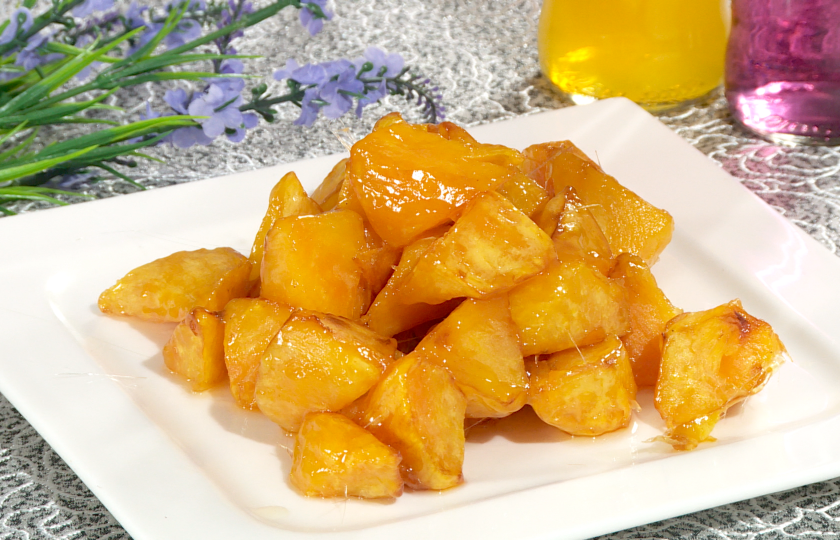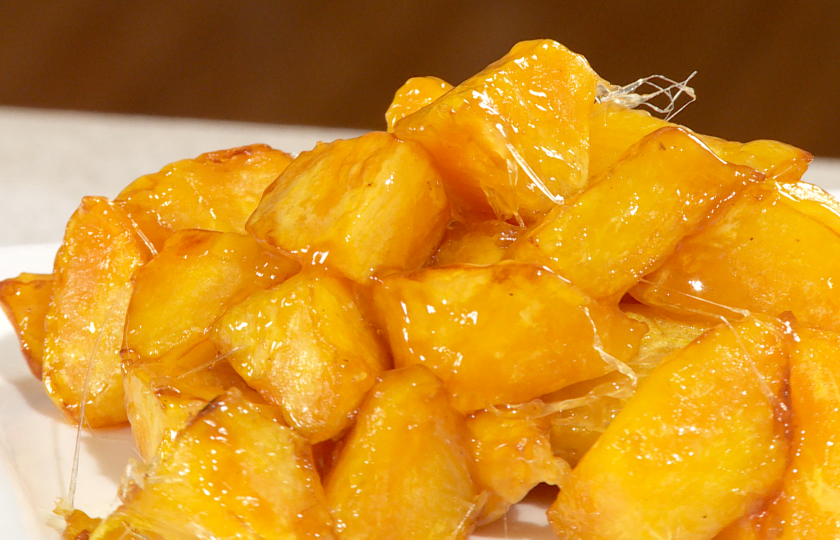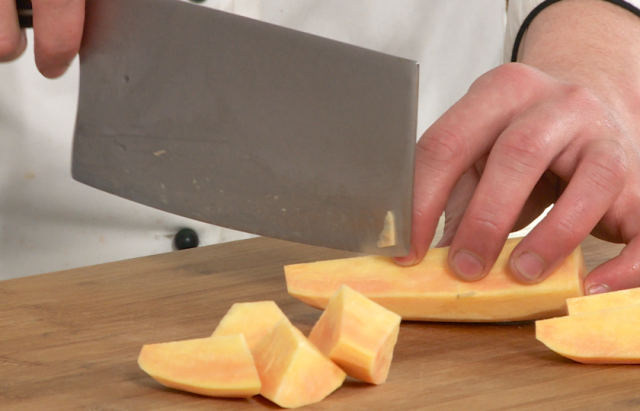Delectable Candied Sweet Potatoes


I am full of anticipation and ready to make a mouthwatering candied sweet potatoes! Its golden and crispy appearance, sweet and glutinous interior, and the wonderful texture of being able to pull out long sugar threads make people unable to resist drooling just thinking about it. Don't worry that the production process will be difficult. I will clearly present every detail to you. As long as you follow my steps, you will definitely be able to successfully make this delicious dish!
Ingredients Needed and Substitutions
Main ingredients
Sweet potatoes: The main ingredient, with a sweet and glutinous taste, providing the main texture and nutrition for the dish.
Seasonings
White granulated sugar: The main ingredient. After stir-frying, it wraps a sweet coat on the sweet potatoes.
Cooking oil: One of the main ingredients. Used for frying and stir-frying to give the sweet potatoes crispness and color.
Substitutions
Sweet potatoes: If there are no sweet potatoes, purple sweet potatos can be used instead, but the taste and sweetness may be slightly different.
White granulated sugar: Can be replaced with rock sugar. The finished product may have a brighter color.

What tools are needed
Cookware:
Frying pan: Prepare a relatively deep wok or frying pan for frying sweet potatoes. Because more oil is needed for frying, sufficient depth can prevent oil from overflowing and ensure that the sweet potato pieces can be completely immersed in it and heated more evenly.
Sugar frying pan: You also need a small pan to fry white granulated sugar. A frying pan with a certain thickness is appropriate. It can make the sugar heated evenly and precisely control its melting process and color change. This is very crucial for making the candied effect.
Stove:
Both gas stoves and induction cookers can be used. The key is to be able to provide stable heat. Use medium-high heat to quickly heat the oil when frying sweet potatoes to make the skin crispy; when frying sugar, use low heat to slowly melt the white granulated sugar to the appropriate color and viscosity.
Strainer:
After frying sweet potatoes, use a strainer or skimmer to scoop out the sweet potato pieces. The mesh size is moderate, which can block the sweet potato pieces and drain the oil smoothly.
Precautions
Safety protection: When frying, hot oil is easy to splash. Be sure to wear long sleeves, an apron and gloves to prevent burns; when frying sugar, keep it on low heat throughout the process. High sugar temperature is easy to scorch and splash and hurt people.
Oil temperature control: The oil temperature for frying sweet potatoes should not be too high, otherwise the skin will be charred black and the inside will not be cooked; if it is too low, it will absorb more oil and not be crispy. When frying sugar, if the fire is too high, the sugar liquid will quickly turn black and bitter, ruining the whole dish.
Eat immediately after finishing: Candied sweet potatoes should be eaten while they are hot. After they cool down, the sugar threads will harden and the taste will deteriorate. If you want to prolong the candied time, you can put the plate in hot water to warm it slightly before serving the dish.
Storage tips
Storage on the same day: If you want to eat it in a short time, put the candied sweet potatoes in a covered container and place it in a cool and ventilated place. This can slightly slow down the hardening of the sugar threads. However, the taste will still deteriorate after a few hours. It is advisable to enjoy it as soon as possible.
Refrigerated storage (1 - 2 days): Seal it in a fresh-keeping box or plastic bag and put it in the refrigerator's refrigeration compartment. Low temperature can delay spoilage and keep the sweet potatoes glutinous. However, the sugar threads are easy to absorb moisture and become sticky and lose the candied appearance. Reheating before eating can improve the sticky feeling, but the original taste is difficult to restore.
Frozen storage (about 1 month): Put it in a sealed fresh-keeping bag or container, and divide it into portions according to the amount of food before putting it in the freezer. This can lock in the flavor and extend the shelf life. But after thawing, the sweet potatoes are easy to become soft and mushy, and the sugar threads are seriously deformed. Use an oven or microwave to reheat at low temperature. You should also finish eating it quickly afterwards to avoid repeated freezing and thawing resulting in a decline in quality.
INGREDIENTS
Main Ingredients
-
·450g sweet potatoes
Seasonings
-
·1015ml cooking oil
-
·20g white granulated sugar
COOKING STEP
Step 1
Peel 450 grams of sweet potatoes and cut them into 2-3 centimeter chunks.

Step 2
Pour 1000 milliliters of cooking oil into the pot and heat it up.

Step 3
Put in the cut sweet potato pieces for frying.

Step 4
Fry until both sides of the sweet potato pieces are golden yellow, then take them out and drain the oil.

Step 5
Start another pot, pour 15 milliliters of cooking oil and heat it up.

Step 6
Add 20 grams of white granulated sugar and stir-fry on low heat until it melts and changes color.

Step 7
Put in the fried sweet potato pieces and quickly stir-fry evenly.

Step 8
Continue to stir-fry until the sweet potato pieces are evenly coated with granulated sugar, then it can be taken out of the pot.

More recipes worth trying
Delectable Crispy Chicken Recipe
Homemade Chicken Nuggets Air Fryer
Authentic Sichuan Delicacy: Sweet Noodles
What foods to pair with
Side dish combinations
Vegetable salad: A combination of lettuce, cucumbers, etc., drizzled with oil and vinegar dressing. The refreshing sour and sweet taste complements the sweet and glutinous taste of candied sweet potatoes, resolving the sweetness and greasiness and enriching the taste levels.
Cold dressed bean sprouts: Blanch the bean sprouts and add minced garlic, vinegar, etc. for cold dressing. Crisp, sour and spicy, neutralizing the sweetness and stimulating the appetite, complementing the candied sweet potatoes.
Steamed corn: It has its own natural sweetness and grain fragrance, and is glutinous and chewy. Both are coarse grains and the tastes are compatible with candied sweet potatoes. The delicate fragrance relieves greasiness and is filling and delicious.
Drink pairings
Yogurt: Plain yogurt is thick, sour and fragrant, and has a thick texture. Eating it with candied sweet potatoes, the sour and sweet milk fragrance is wrapped with the sweet fragrance of sweet potatoes, enriching the taste and also relieving greasiness.
Lemonade: Soak fresh lemon slices. It has a rich fruity fragrance and a refreshing sour taste, reducing the sweetness and greasiness and helping the taste buds stay sharp to fully enjoy the deliciousness.
Can other sauces be added
The traditional method of making candied sweet potatoes pursues the pure candied effect and the original taste of sweet potatoes. However, pairing with specific sauces can create novel flavors.
Osmanthus honey sauce: Osmanthus honey has a delicate floral fragrance and sweet taste. It has a thick texture and a rich fragrance. After the candied sweet potatoes are wrapped with sugar threads, drizzle a little osmanthus honey sauce. The floral fragrance permeates the sweet and glutinous sweet potatoes, adding an elegant osmanthus fragrance to the rich sweetness, enriching the taste levels and adding a touch of poetry to the traditional flavor. It is very suitable for diners who pursue a fresh and sweet taste.
Chocolate sauce: The thick and smooth chocolate sauce can collide with candied sweet potatoes to create a wonderful spark. The rich milk fragrance and mellow bitterness of chocolate are intertwined with the sweet fragrance of sweet potatoes and the crisp sweetness of sugar threads, balancing the bitterness and sweetness. It is especially suitable for people who like Western flavors and are keen on creative dessert combinations. When eating it, it is like tasting a special "Chinese chocolate dessert".
Yogurt sauce: Make yogurt sauce with yogurt, honey and lemon juice. It is sour, sweet and fresh, and has a smooth and flowing texture. Drizzle it on candied sweet potatoes. The sour and sweet taste reduces the sweetness and greasiness. The milk fragrance of yogurt sets off the fragrance of sweet potatoes. The entrance is more refreshing and appetizing, bringing a different kind of enjoyment to people who prefer a refreshing taste and want to relieve the greasiness of sweet and greasy dishes.
FAQs:
However, this ratio is only a reference range. If the sweet potato pieces are cut larger, in order to ensure a good candied effect, the amount of sugar can be appropriately increased; on the contrary, if the sweet potato pieces are small, the amount of sugar can be slightly reduced. At the same time, different varieties of sweet potatoes also have different sweetness. For example, red-hearted sweet potatoes are relatively sweet, and the amount of sugar can be reduced accordingly.
After the sugar is completely melted, if you want to accelerate the color change to the ideal caramel color, you can turn to medium heat, but keep a close eye. At this stage, the sugar temperature rises quickly. Within 30 seconds to 1 minute, the color will change from light yellow to dark amber, and dense bubbles will appear. Once it reaches the standard, immediately turn to low heat or turn off the heat, otherwise it will easily become burnt and bitter.
In the final stage, when the sugar liquid is in a candied state, decisively turn to low heat or turn off the heat. Quickly put in the fried sweet potatoes and wrap them with sugar while taking advantage of the residual heat. Skillfully use the residual heat to make the sweet potatoes evenly coated with sugar. Only by precisely controlling the fire in this way can a perfect candied sweet potato be made.
The key to the frying process lies in the oil temperature and turning. First pour about 1000 milliliters of oil and heat it to 60% heat (about 160℃. Test the temperature with a small piece of sweet potato. When dense bubbles appear around it, it reaches the standard). The appropriate oil temperature helps the surface of the sweet potato quickly form a hard shell and lock in moisture, and the inside is heated evenly. Then, during the frying process of 5-8 minutes, use a spatula or chopsticks to gently turn it every 1-2 minutes to ensure that all sides are immersed in hot oil.
If there are a large amount of sweet potatoes, be sure to fry them in batches. Putting in too many at once will lower the oil temperature and cause uneven heating. Operate each batch in the same time and turning method. By grasping these points, the fried sweet potatoes will be golden in color and evenly crispy.
During operation, being quick is crucial. When the sugar liquid reaches the candied state, quickly put in the fried sweet potatoes, evenly coat them with sugar and then immediately serve them on a plate, reducing the contact time between the sugar liquid and cold air. If conditions permit, multiple people can work in cooperation. Each person is responsible for frying, frying sugar, and coating with sugar and serving on a plate, with tight connections to shorten the process time to the greatest extent.
In the sugar frying process, a little oil can also be added, just 1-2 milliliters of cooking oil or butter. It forms an oil film to slow down the heat loss and help keep the sugar liquid warm. However, the amount must be well controlled to avoid affecting the candied effect and taste. By comprehensively applying these methods, the candied time can be prolonged.

















